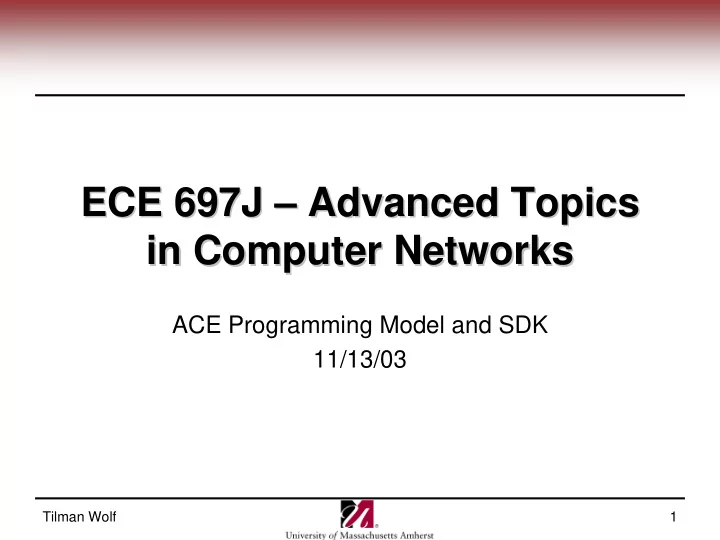

ECE 697J – – Advanced Topics Advanced Topics ECE 697J in Computer Networks in Computer Networks ACE Programming Model and SDK 11/13/03 Tilman Wolf 1
Overview Overview • Programming Model – Active Computing Element (ACE) Abstraction – Allocation of ACEs to microengines – Packet Queues • Software Development Kit – Simulator – Example: IP forwarding • Lab 2: IP forwarding and classification on IXP1200 Tilman Wolf 2
3 • Active Computing Element (ACE) abstraction: Last Class Last Class Tilman Wolf
Microengine Assignment Assignment Microengine • Packet processing involves several microblocks • How should microblocks be allocated to microengines? – One microblock per micorengine – Multiple microblocks per microengine (in pipeline) – Multiple pipelines on multiple microengines • What are pros and cons? – Passing packets between microengines incurs overhead – Pipelining causes inefficiencies if blocks are not equal in size – Multiple blocks per microengine causes contention and requires more instruction storage • Intel terminology: “microblock group” – Set of microblock running on one microengine Tilman Wolf 4
Microblock Groups Groups Microblock • Microblock groups can be replicated to increase parallelism Tilman Wolf 5
Microblock Group Replication Group Replication Microblock • Performance critical groups can be replicated: • Additional complexity: – Single core component (not replicated) communicates with multiple groups – Multiple inputs, multiple output Tilman Wolf 6
Control of Packet Flow Control of Packet Flow • Packets require different processing blocks – IP requires different microblocks than ARP – Special packets get handed off to core • “Dispatch Look” control packet flow among microblocks – Each thread runs its own dispatch loop – Infinite loop that grabs packets and hands them to microblocks – Return value from microblock determines the next step • Invocation of microblock is similar to function call Tilman Wolf 7
8 Dispatch Loop Dispatch Loop – Two microblocks (ingress + IP) • Example: Tilman Wolf
Dispatch Loop Conventions Dispatch Loop Conventions • Parameters passed to microblock: – Buffer handle for frame that contains a packet – Set of state registers that contain information about the frame – A variable called dl_next_block in which return value gets stored • State registers: – Information about packet: length – Information generated by software: classification result – Registers can be changed by microblock • Return values: – Meaning assigned by programmer – Conventions: zero = “drop packet”, other values for “pass on” and “send to core” etc. Tilman Wolf 9
Packet Queues Packet Queues • Packet flow depends on packet data • Processing time depends on packet data • Packet movement can’t be predicted – Microblocks need to continue processing without waiting • Packets need to be buffered – “Communication Queues” – Unidirectional FIFO (yes, really FIFO) – Bidirectional communication requires two queues • Also between microblocks and core – Single queue for all microblock group instances – Uses exception mechanism “IX_EXCEPTION” – Exception handler in core determines further steps Tilman Wolf 10
11 Packet Queue Example Packet Queue Example Tilman Wolf
Crosscalls Crosscalls • Mechanism for non-packet communication between ACEs – Similar to remote procedure calls and remote method invocations • Caller and callee need to agree on parameters – Interface Definition Language (IDL) specifies details – IDL compiler creates “stubs” to handle marshaling • Types of crosscalls – Deferred: caller does not block, asynchronous notification – Oneway: caller does not block, no return value – Twoway: caller blocks, callee returns value • ACEs are prohibited from twoway calls – No blocking allowed • Other control software (non-ACE) may use all types Tilman Wolf 12
13 SDK SDK • Software Development Kit: Tilman Wolf
14 Software Setup Software Setup Tilman Wolf
Simulator Simulator • Cycle-accurate simulation of IXP1200 • Allows for easy experimentation – Packet generator – Visualization for thread behavior, memory accesses – Runs under Windows • We will use simulator for Lab 2 – Part I: run existing IP forwarding example, collect statistics – Part II: make a minor modification for classification • We have lab machines set up for you – You can also install simulator on your own machine (big!) Tilman Wolf 15
IP Forwarding Example IP Forwarding Example • Full-blown RFC1812-compliant IP forwarding – Lots of special cases – Look for main program structure – 4 uE for IP processing (0-3) – 3 uE for output queuing (4-5) • Run program and collect workload statistics – Thread behavior – Memory accesses – Instruction coverage – Etc. Tilman Wolf 16
17 Tilman Wolf
18 Tilman Wolf
19 Tilman Wolf
20 Tilman Wolf
21 Tilman Wolf
22 Tilman Wolf
23 Tilman Wolf
24 Tilman Wolf
25 Tilman Wolf
26 Tilman Wolf
27 Tilman Wolf
28 Tilman Wolf
29 Tilman Wolf
Lab 2 Lab 2 • Part I: Collect statistics – Microengine utilization for all microengines – Detailed statistics of one thread from uE 0 and one from uE 5 – Processing power of microengines (in MIPS). – Memory utilization and bandwidth. – Latency distribution for SDRAM refs for microengine 0 and SRAM non-read_lock refs for microengine 0. Show a graph. – Show a screenshot for the thread history that shows overlapping SRAM and SDRAM requests by the same microengine. – Identify the overall delay for either request (in cycles). What factors contributed how much to the overall delay? • DUE NEXT TUESDAY. Tilman Wolf 30
Lab 1 Results Lab 1 Results • Grading: 20 points total – Results: 10 points – Code: 3 points – TCP state machine + explaination: 2+1 points – IP and TCP headers: 1+1 points – Report (written content): 2 points • Average: 16.6 • Max: 20 • Min: 14 Tilman Wolf 31
Next Class Next Class • Microengine programming – Assembler – Instructions – Register access – Assembler directives – Etc. • Read Chapter 24 • Turn in Part I of Lab 2 Tilman Wolf 32
Recommend
More recommend